INTRODUCTION
We report here on the journal’s operations from January 1, 2017 to December 31, 2017. This includes the final six months of Perspectives at Indiana University and its move to the University of Florida (UF) on June 1, 2017. We concentrate on the latter. This report covers the transition from Indiana to Florida, the editorial and technical innovations introduced by the UF editorial team, and reports summary statistics on submissions, editorial decision making, impact, and book review commissions, comparing the tenure of the UF team to the recent past.
TRANSITION TO THE UNIVERSITY OF FLORIDA
The editing of Perspectives on Politics at the University of Florida commenced on June 1, 2017. The transition was complicated by the fact that the incoming editor in chief, Michael Bernhard, ruptured his quadriceps tendon in early May on a trip overseas and underwent reparative surgery only on May 15, 2017. He was thus unable to attend the orientation meeting planned by Cambridge University Press in New York. The slack was taken up by associate editor Daniel O’Neill and managing editor Jennifer Boylan, and the success of the transition was attributable in no small part to the extra effort they put in during this period.
Despite this mishap, the team managed to put the full infrastructure (office space, web interface, staffing, and training) for the editors and six editorial assistants in place on time on June 1. Substantial support in accomplishing this was provided by Cambridge University Press, APSA, and the outgoing team at Indiana University. Barbara Walthall, Jeffrey Isaac, and Mark Zadrozny and their staffs went out of their way to answer our questions, provide insight, and expedite the transfer.
The first task upon taking responsibility for the journal was to complete the editorial and production process for issue 15(3) which had been assembled and put into production by Indiana. This was useful in teaching the staff their responsibilities in the production process. The team met this challenge.
Indiana thankfully left us with a cushion of accepted material to publish both on the article and book review sides. However, as expected, there was also a substantial backlog on both sides that needed to be cleared out. In its last month, Indiana shipped us several hundred books and these had to be organized and prepared for review. Furthermore, within Editorial Manager we needed to familiarize ourselves and process articles under review and process the few dozen new manuscripts which Indiana did not process during their last month, as they were turning the journal over to us. While very time consuming, clearing the backlog allowed us to create and put in place our own procedures for the review of articles, editorial decision making, and the review of books.
EDITORIAL INNOVATIONS
Reinforcement of Review Process Anonymity
Upon taking control of the journal we were besieged by a large of number of inquiries and requests of the following nature:
“Would you be interested in an article on…”?
“Could you read over my manuscript and tell me if you would be interested in publishing it?”
“Would you please review my book? I can recommend the following readers….”
“I would like to review _____’s book, entitled….”
“I would like to do a review essay of the following books: […]. Would it be possible to have them sent to me?”
With regard to articles we felt that such requests could influence the fairness of the review process, by undermining the double blind nature of the editorial decision on whether to proceed to external review or reject submissions without external review. With regard to book reviews, we felt that requests could undermine the impartiality of the reviewer selections process (either in a positive or negative direction). As a result of this flood of requests, we introduced new language on the website, to reduce attempts to influence the review process and to combat any perception that such influence was possible:
The Editorial Team at Perspectives on Politics uses a double-blind review process for all manuscripts. Please do not email the Editors with information about your manuscript asking if you should submit your manuscript for review, as this ‘un-blinds’ the manuscript review process. General inquiries may be directed to the Managing Editor, Jennifer Boylan, at [email protected].
The editorial Team at Perspectives does not entertain suggestions or proposals for book reviews. Book reviews are designed and assigned by the editorial staff. If you would like to have your book considered for review, please request your publisher to send a copy of your book to the address listed below.Footnote 1
Thematics
One of the consistent features of Perspectives on Politics is the publication of clusters of thematically related articles together in one issue. For instance, issue 15(2), the last fully produced by Indiana, was devoted to the study of post-communist politics. In our estimation, these periodic theme-focused issues and sections are one of the unique and innovative features of the journal. In the past, they have emerged in a more haphazard fashion, on the basis of what comes across the Editorial Manager transom, and then finding ways to connect them. We have continued to do this. The first issue that we produced on our own, 15(4), brought together a series of articles which all addressed “Problems of the State in the Developing World.” In 16(1) we have an extensive special section on “The Politics of Inclusion and Exclusion.” In issue 16(2) we will be clustering a series of articles on the new contentiousness of American politics. And finally, later this year, if work in the editorial queue is finished in time, we hope to do a special section on “Cyberpolitics.”
While we feel we have been quite fortunate to have these clusters emerge naturally, we have taken a more proactive stance to cultivate groups of articles on emerging and highly relevant themes through calls for papers. To date we have issued two calls.Footnote 2
One of the ways we have tried to cultivate such calls is to encourage board members to propose them and take part in the editorial process as guest editors. The first foray of this kind was proposed by professor Samantha Majic on the “Politics of Celebrity.” Together we issued a call for papers and enlisted Professor Majic to act as guest editor on the section. To date we have received two submissions and have not accepted any articles. More ambitiously, we have issued a call for a full issue on “The Trump Presidency: Causes and Consequences.” We have already received several submissions and some are under active review.
Transparency
Perspectives was one of the major journals not to sign the Journal Editors’ Transparency Statement (JETS). While the former editor and the board were highly supportive of research transparency and replicability (where appropriate), there was extensive concern over whether DA-RT and JETS had a onesize-fits-all notion of research and how to implement transparency.Footnote 3
The present editorial staff shares these concerns, and is interested in promoting data transparency and the replicability of work where it is appropriate.
To this end, the first of our innovations has been working with Cambridge to create a Perspectives on Politics Dataverse. It should be up and running for issue 16(1). Given that the norm of posting replication data and do-files for quantitative work is widespread and has broad support in the discipline, we are now requiring quantitative publications in the journal to post a replication package to the Dataverse.
With regards to qualitative work we are being more cautious in terms of implementing universal standards for data and inferential transparency. We are actively working with individual scholars to cultivate new ways of doing this, and are encouraging them to use online appendices, so as not to crowd out substantive content in the body of the journal itself. There are qualitative articles in the pipeline which will make use of the Syracuse Qualitative Data Repository and we are poised with an article that is currently under “minor revision” to do a pilot experiment with active citation.
We are also in the process of studying the replication and transparency statements of other major journals so as to update the online “Statement on Scholarly Recognition.”Footnote 4
In this regard we find the policies recently implemented by the American Political Science Review to be flexible, pragmatic and tolerant and we are thinking through what, if anything, Perspectives needs or wants to add to them to better serve the membership, and the part of the discipline which reads and supports the journal.
TECHNICAL INNOVATIONS
Front-End Manuscripts
We easily adapted to the Editorial Manager submission, processing, and review systems for manuscripts. We did, however, implement a couple of technical innovations in this regard. First, and most significantly, we have begun to experiment with publishing manuscripts on FirstView, and to date five items have appeared in this format. This has often been at the behest of authors looking to publicize their work. It has also been initiated by us for standalone pieces which we think will draw broad public attention (such as David Lake’s presidential address). Second, in January we activated Publons, an online app that credits reviewers for their service. We hope that such recognition allows those who shoulder a heavy disciplinary service burden through review to document their records for their colleagues and employers.
Book Review Section
At Indiana, book reviews were commissioned and processed using an email system. At the request of APSA and Cambridge University Press we moved the book review commissioning, submission, and production process into Editorial Manager. This required close cooperation with Cambridge to develop an effective workflow system that included several discrete processes:
1. the creation of an assignment file;
2. sending invitation letters to individuals asking them to review books;
3. sending commission letters once an individual agrees to a review, outlining the requirements and format of the review;
4. setting up a system of reminder letters sent to individuals who are late to respond to the original invitation or who are late to send in their book review;
5. collecting author drafts as Editorial Manager submissions;
6. working with authors to edit the manuscripts;
7. setting up a system for handling copyright transfer; and
8. transferring final drafts to Cambridge for production.
Production
Under the leadership of managing editor Jennifer Boylan, our team has worked hard to move the publication schedule closer to on-time, and we have made significant improvements in this regard. The online publication of issues 15(1) and 15(2), both published before our tenure, occurred about four weeks after the scheduled online publication date. The first issue that we managed, 15(3), published online 10 days after the scheduled date, while the second issue we managed, 15(4), published online eight days after the scheduled date. Issue 16(1) is currently on schedule to publish on time and we intend to continue to improve the production processes in order to consistently publish on time. The improvement in the meeting of these deadlines is largely due to a number of innovations to the proofing and revision process which diminish the need for repeated proofing, particularly for book reviews. In addition, we have stopped holding manuscripts for each issue and submitting them as a package. We now send manuscripts to Cambridge for production as soon as we have scheduled them for publication in a specific issue.
We have also worked carefully with Cambridge University Press to try to hit the page budget for each issue. Issues 15(1)–15(3) were an average of 18 pages over the page budget. To hit the annual target limits we printed Issue 15(4) slightly under the page budget. Estimates for the 16(1) page count put us very close to the 296 budgeted editorial pages.
Other Innovations
We have increased Perspectives on Politics’ activity on Twitter, resulting in a 20% increase in followers since August 2017. We are in the process of reviewing and synchronizing the Cambridge Core and APSA websites, and updating and editing the text and pdf links with regard to submission, formatting, and scholarly recognition. We have cleaned up Editorial Manager, including withdrawing “zombie submissions” (submissions abandoned by authors, duplicate files) and moved submissions already published but remaining in the EM workflow process out of EM working folders.
SUBMISSIONS AND PROCESSING
Number of Submissions
In 2017 we received 296 new manuscripts, and 80 revised manuscripts. Of these, 180 new and 50 revised were processed by the UF team. The total is somewhat less than the high of 321 received in 2016. However this is up substantially from previous years (see table 1). We suspect that the difference between the first and second halves of 2017 is due to author reticence to submit manuscripts to an outgoing editorial team and optimism about prospects for publication under a new editorial team.
Table 1 PoP Manuscript Submissions per Year
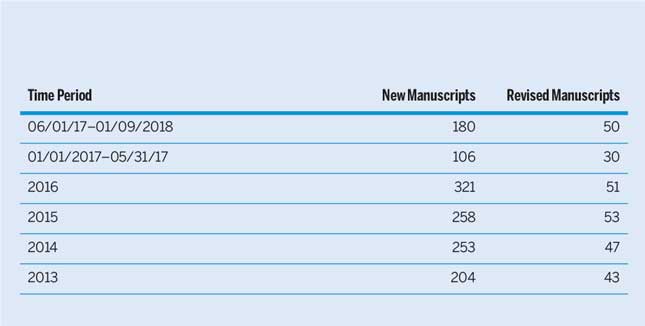
APSA flagship journals not only play an important role in the discipline domestically; they are publications of international importance. One of our stated goals is to further internationalize the authorship base and audience. Table 2 shows the increasing rate of submissions from authors based in countries other than the United States. It is now consistently over 40% and peaked in the second half of 2017 at 43.6%.
Table 2 PoP Manuscript Submissions by Location of Corresponding Author
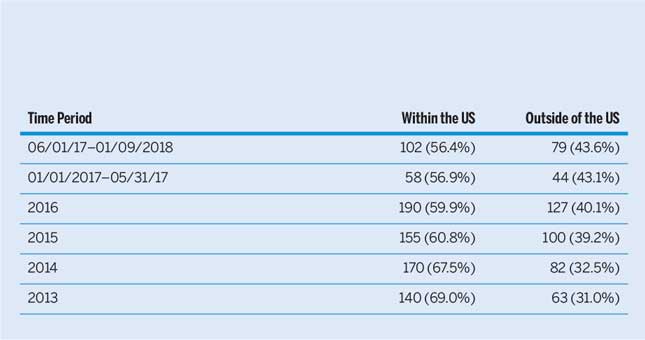
Processing of Submissions
One of our goals upon assuming editorship of the journal was to maintain its record of prompt and professional review of manuscripts. Perspectives invites, at minimum, four reviewers on the first round for articles. If we receive two recommendations of rejection before all reviews are in, we terminate the process early. An acceptance on the first round is exceptionally rare, and has not happened since we began to edit the journal. Many manuscripts go through the revise and resubmit stage twice. On subsequent rounds, all four initial reviewers are often willing to read the revisions. When they are not, we try to avoid adding new reviewers, and only do so when the number of reviewers reading the revisions falls below two. Because of the stringent nature of peer review at the journal and the large number of reviewers, we work hard to be efficient and stay on top of manuscripts. The results of those efforts are visible in the statistics presented in table 3.
Table 3 Average Number of Days in Review Process
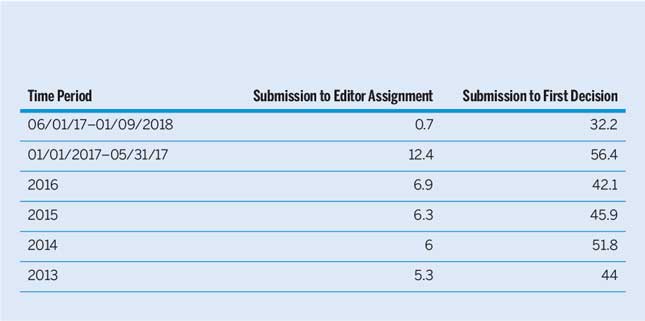
As is apparent in table 3, the time to editor assignment and first decision has been substantially condensed since we began to edit the journal on June 1, 2017.
Editorial Decisions
Table 4 summarizes the editorial decisions taken since we assumed editorial responsibilities. As in the past the majority of manuscripts are rejected without external review. Generally speaking these submissions were not appropriate to the journal either because they were not academic political science papers, were too specialized for a general interest, public-sphere focused journal like Perspectives, or were of poor quality. Of the 70 submissions that went out for external review, over 60% were subsequently rejected. The remainder were given a chance to revise and resubmit their manuscripts. The overwhelming number of these decisions asked for major revisions. No manuscript has been accepted without at least minor revision under our stewardship.
Table 4 Editorial Decisions by the UF Team
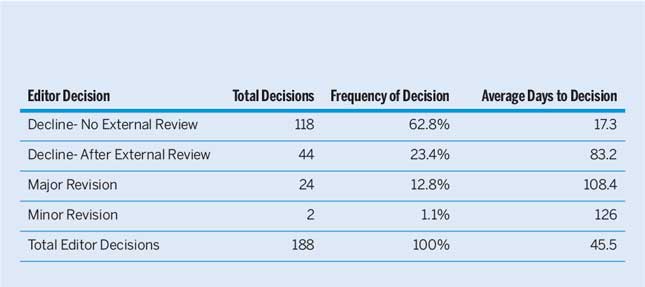
The vast majority of manuscripts given a revision decision under our editorship have been published. To date, 18 have found their way to print or the production queue. Three were rejected after the first round of revision when reviewers returned harsh verdicts. The remaining five are back with the authors or reviewers and do not yet have a final disposition. The overall acceptance rate for submissions at UF is presently 9.5%. Because the fate of five manuscripts under revision is still unknown this could rise to as high as 12.2%.
Table 5 presents data on the outcomes of the publication decision-making process. While it is our intention to reduce the number of manuscripts rejected without external review, the decline in comparison to 2014–2016 is only modest (∼6%). Unless authors read our mission statement more carefully and until we receive more uniformly excellent papers, changing this will be difficult. Given our use of four reviewers, and our desire to use well-known experts as a means of quality assurance, wasting our credibility in that reviewer pool by sending out a large number of weak or narrow manuscripts would make it harder to get the kinds of reviews that promote the quality of the journal. We believe our review process is highly competitive and that our readers provide our authors with excellent advice on how to make their strong submissions even better.
Table 5 Outcome of 1st Round of the Review Process (percentage)
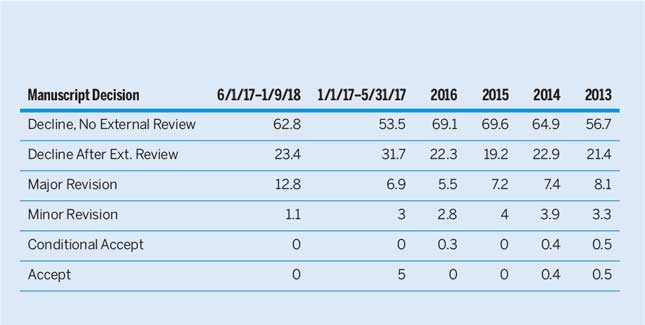
Another change in the journal’s practice since UF began its tenure is that, so far, we require major revisions more frequently. That also means, on the first round, we call for minor revisions with less frequency and have yet to issue a conditional or outright accept.
Journal Impact
Table 6 presents the Thomson-Reuters JCR annual and five-year impact factors, and the rank of the journal in the discipline based on the former.
Table 6 Journal Impact 2012–2016
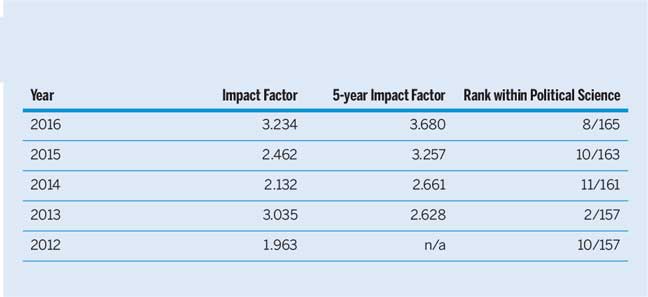
Over the last five years, the journal’s impact has increased and it is now with some consistency seen as a top ten journal in the discipline. For a relatively new journal (with the publication of issue 16(1) we will celebrate our fifteenth anniversary), this is a very good outcome. We expect that the annual impact factor will fall off somewhat next year because a pair of highly cited articles will fall out of the window of consideration.Footnote 5
While the annual impact has greater variance, we see a steady increase in the five-year impact, showing the journal is effectively establishing a position of importance in the discipline’s publishing history. In this regard, Perspectives should be seen as both a sound and highly successful endeavor by the association.
The Book Review Section
The Book Review section has historically been and continues to be a core mission of the journal. Being reviewed in Perspectives sends a signal to the discipline. A review in the journal is a mark of the significance of a newly published book and the review itself can serve as an important bit of evidence of impact and in promotion and tenure decisions. The review mission is not a sideline of the journal, but a central function, of equal importance to the publication of articles. Lining up reviewers is an onerous task that involves persistence due to a large number of rejections of invitations. Table 7 compares the rate of rejection for book review invitations to that of article review rejections on the front end. While only 40% of article review requests were turned down in the last six months, over 60% of book review requests are rebuffed. This necessitates multiple invitations, often several.
Table 7 Reviewer Invitations

Table 8 shows the book reviews that the UF team has commissioned since we assumed responsibility for the journal. These include conventional book reviews (single, double, and triple), review essays (multiple books reviewed by a single author in a more extended format), critical dialogues (where two authors of related books review each other’s work and respond to one another), and review symposia (where multiple authors review a book of potential import). These are broken down by field. The table includes both completed and forthcoming reviews.
Table 8 Book Reviews Commissioned: June 1, 2017–January 9, 2018
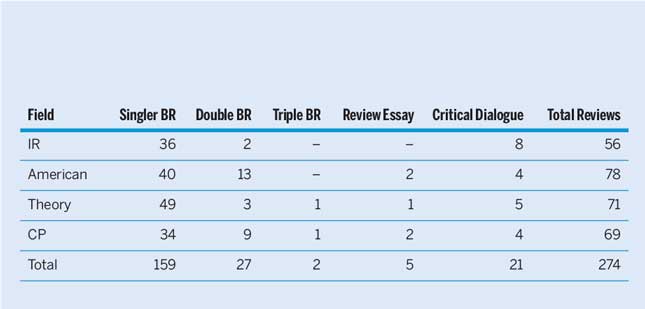
To date we have commissioned 274 book reviews. Most volumes of the journal contain between 360 and 400 reviews (90–100 per issue). Thus we are ahead of the curve to hit our target for the first year. There is a slight imbalance now between IR and the other three fields. We are actively working to correct this as much as possible, but there seem to be fewer books in IR than the other fields.
CONCLUSIONS
The UF editorial team has successfully negotiated the transition and established a set of normal procedures for assuring the continuity and quality of the journal. We have also introduced a number of substantive and technical innovations that we hope will contribute to the continued success of the journal. We wish to express our thanks to APSA, Cambridge University Press, and our precursors at Indiana University for their support in this endeavor. Our experience has been both challenging and rewarding. We look forward to continuing to work for the welfare of the association and the discipline in the coming year.










